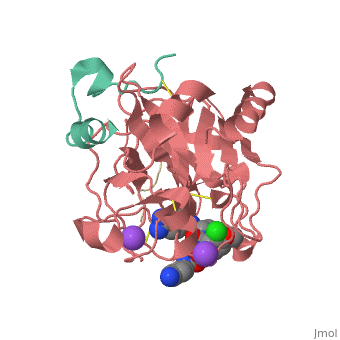Sean Swale/Human Thrombin Inhibitor
From Proteopedia
(Difference between revisions)
| Line 1: | Line 1: | ||
== Human Thrombin Inhibitor == | == Human Thrombin Inhibitor == | ||
| - | Thrombin is a serine protease that cleaves fibrinogen to allow fibrin to form stringy networks that trap red blood cells to form clots. Thrombin is a serine protease because it cleaves fibrinogen with its serine residue. Thrombin when made by the body is tethered to blood vessels so that it cannot cause clots throughout the body causing strokes and heart attacks. Additionally, thrombin is only activated for a few seconds to limit the clotted area to the injured area<ref> | + | Thrombin is a serine protease that cleaves fibrinogen to allow fibrin to form stringy networks that trap red blood cells to form clots. Thrombin is a serine protease because it cleaves fibrinogen with its serine residue. Thrombin when made by the body is tethered to blood vessels so that it cannot cause clots throughout the body causing strokes and heart attacks. Additionally, thrombin is only activated for a few seconds to limit the clotted area to the injured area<ref>http://www.rcsb.org/pdb/education_discussion/molecule_of_the_month/download/Thrombin.pdf </ref>. In cases such as dialysis a blood thinner like hirudin is needed to make sure a blood clot is not created in the body. Unfortunately, hirudin |
Revision as of 23:25, 13 November 2012
Human Thrombin Inhibitor
Thrombin is a serine protease that cleaves fibrinogen to allow fibrin to form stringy networks that trap red blood cells to form clots. Thrombin is a serine protease because it cleaves fibrinogen with its serine residue. Thrombin when made by the body is tethered to blood vessels so that it cannot cause clots throughout the body causing strokes and heart attacks. Additionally, thrombin is only activated for a few seconds to limit the clotted area to the injured area[1]. In cases such as dialysis a blood thinner like hirudin is needed to make sure a blood clot is not created in the body. Unfortunately, hirudin
Introduction
| |||||||||||

